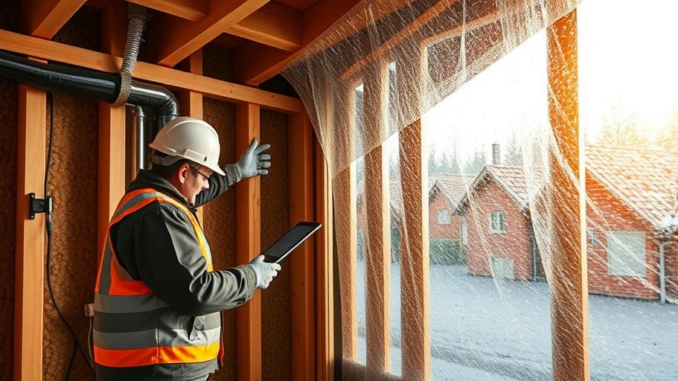
Summary
Transform your building into an energy-efficient powerhouse with these actionable steps. From insulation upgrades to smart technology integration, discover how to minimize energy waste and maximize savings. This guide empowers you to create a greener and more cost-effective building for the future.
Successful low-energy building design hinges on careful planning. Focus360 Energy can help.
** Main Story**
Alright, let’s talk about making existing buildings way more energy-efficient. Seriously, the long-term cost savings are huge, and, of course, it’s better for the planet. Plus, everyone’s happier when they’re comfortable! Think of it as a win-win-win. So how do you actually turn your building into an energy-saving machine? Well, here’s a breakdown of actionable steps you can take. Let’s dive in.
Step 1: The All-Important Energy Audit
First things first, you need to know where you’re starting from. I mean, how can you fix a problem if you don’t know what it is? Start by really digging into your energy bills. Get a professional energy audit – it’s worth the investment. If your building’s got a Building Management System (BMS), that’s gold! Use it to see where energy is really being used. Heating, cooling, lighting, even the water heater, are generally the biggest culprits. Once you’ve identified your high-usage areas, prioritize them based on potential savings and how much it’ll cost you to fix. You can’t just spend money wildly, there is a business to run after all!
Step 2: Sealing the Deal (Building Envelope, That Is)
Think of your building envelope – the walls, roof, windows – as its skin. A leaky, poorly insulated building is like wearing a t-shirt in winter. Improve insulation in the walls, roof, and floors – that’s key. Then, go around and seal every air leak you can find, especially around windows and doors. It’s amazing how much difference this makes. Trust me, you’ll be reducing those sneaky drafts, and maintaining a consistent temperature isn’t only good for comfort, it’s good for savings.
Oh, and while you’re at it, if you’ve got ancient windows, seriously consider upgrading to energy-efficient models. The ones with low-E coatings and insulated frames? Fantastic.
Step 3: HVAC Optimization: Making Your System Sing
HVAC systems, those sneaky energy hogs, are often a huge chunk of a building’s energy bill, I mean, it’s usually about half! Upgrade to high-efficiency equipment; look for ENERGY STAR certified models. It’s a no-brainer really. But the equipment isn’t the end of the story! Regular maintenance is essential, too. Filter replacements, system tune-ups… treat your HVAC system well, and it’ll treat your wallet well. And programmable thermostats or smart thermostats? These are worth their weight in gold, allowing you to adjust temps based on occupancy, time of day, and other factors.
Step 4: Lighting Upgrades: Time to See the Light (Efficiently)
Ditch those old incandescent bulbs already! LEDs are the future. They last way longer and use a fraction of the energy. Plus, they don’t get nearly as hot. Also, if you really want to be clever, install occupancy sensors, so, lights only turn on when someone’s in the room, or daylight harvesting controls, these adjust the light based on how much natural light is available. And consider zoning, so you only light the areas that need it, saves a surprising amount, actually.
Step 5: Water Heating Efficiency: Not Just Hot Air
Low-flow showerheads and faucets? Obvious, but crucial. Insulate your hot water pipes, too – prevents heat loss. Want to go all-in? A tankless water heater or a heat pump water heater is a solid investment. No more heating water all day, every day, just in case!
Step 6: Smart Building Tech: The Brains of the Operation
Smart building tech, such as Building Management Systems (BMS), gives you centralized control over everything from HVAC to lighting. These systems allow for data-driven decisions to optimise energy use. You could also add Smart meters, so you can keep track of consumption patterns. This also empowers you to make the right decisions regarding cost-effective energy strategies.
Step 7: Getting Everyone Onboard: Occupant Engagement
You can do all the upgrades in the world, but if your building occupants aren’t on board, you’re fighting an uphill battle. Educate them! Simple things like turning off lights and unplugging devices when not in use make a difference. You know, just like your mom told you. Maybe even offer incentives for energy conservation. Make it a team effort, and celebrate successes.
Step 8: The Future is Green: Renewable Energy
Finally, think about renewable energy. Solar panels? Geothermal? Wind turbines? Depends on your location and energy needs, of course, but it’s worth exploring. It doesn’t just save you money, it makes a statement.
In conclusion, transforming an existing building into an energy-efficient one takes work, but it’s so worth it. Not just in terms of money, but for the planet, and for the comfort and well-being of the people who use the building. Embrace the future of sustainable design!


“Smart building tech? Brilliant! Now, if only we could get smart *people* tech to ensure everyone actually uses it properly. Incentivized turning-off-lights competitions, anyone?”
Great point! Engagement is key. I think incentivized competitions could be really effective, and make sure everyone is engaged and involved. Has anyone tried any successful occupant engagement strategies? What worked? Would love to hear your thoughts!
Editor: FocusNews.Uk
Thank you to our Sponsor Focus 360 Energy
The suggestion of integrating smart building tech is interesting. How effective are current BMS in adapting to real-time occupancy and usage patterns to dynamically optimize energy consumption, and what are the limitations?
That’s a great question! Current Building Management Systems (BMS) are becoming increasingly sophisticated in analyzing real-time data to optimize energy usage. However, limitations exist in their ability to predict future needs accurately and integrate seamlessly with older building infrastructure. There are a lot of exciting possibilities for further development here!
Editor: FocusNews.Uk
Thank you to our Sponsor Focus 360 Energy
Smart building tech sounds amazing, but I’m envisioning my building’s BMS developing a Skynet-esque personality, demanding we wear thermal underwear in July for “optimal energy conservation.” Then again, cheaper bills… maybe I’m in.
That’s a funny image! While we’re not *quite* at Skynet levels of BMS, the potential for optimization is definitely there. Perhaps there is some risk of overzealous algorithms, but ultimately the goal is to find that sweet spot where comfort and efficiency meet! Cheaper bills *are* a nice perk though!
Editor: FocusNews.Uk
Thank you to our Sponsor Focus 360 Energy
Smart building tech is the brain of the operation? I just hope the BMS doesn’t start leaving passive-aggressive notes on the thermostat: “It would be *great* if someone could remember to close the windows.”
Haha, that’s a hilarious thought! We might not be far off from personalized BMS interfaces though. Imagine the system adapting its communication style to different users! A little humor might actually make energy saving tips more engaging. Maybe a friendly nudge is better than a scolding! What does everyone else think?
Editor: FocusNews.Uk
Thank you to our Sponsor Focus 360 Energy
The point about occupant engagement is critical. Educating occupants on real-time energy consumption via a dashboard could further encourage mindful usage and promote collective responsibility.
Absolutely! A real-time dashboard is a great way to boost engagement. It is a very effective way to promote responsibility. We could also explore gamification, like points for departments that reduce consumption or rewards for innovative energy-saving ideas. Have you seen that implemented anywhere?
Editor: FocusNews.Uk
Thank you to our Sponsor Focus 360 Energy
Regarding occupant engagement, implementing user-friendly interfaces for smart building tech could significantly enhance participation and understanding of energy-saving practices.
That’s a great point! User-friendly interfaces are so important. A simple, intuitive design can make all the difference in encouraging people to actively participate in energy-saving efforts. What features would you like to see in a user-friendly BMS interface?
Editor: FocusNews.Uk
Thank you to our Sponsor Focus 360 Energy
Regarding water heating efficiency, how do heat pump water heaters perform in older buildings with potentially less efficient plumbing and insulation compared to modern construction?
That’s a really important consideration! Heat pump water heaters can still offer substantial savings in older buildings, but you’re right, the existing infrastructure plays a big role. Maybe a hybrid approach of improved insulation paired with the heat pump could be an optimal solution in those scenarios. Anyone have experience with that?
Editor: FocusNews.Uk
Thank you to our Sponsor Focus 360 Energy
An energy audit sounds like homework. Does that mean I’ll get extra credit if I find energy vampires lurking in the server room, sucking the life out of our kilowatt hours? And can we write off ghost hunting equipment as a business expense?
Haha! Energy vampires in the server room! I love that analogy. Think of an energy audit as a treasure hunt. Every kilowatt-hour saved is like finding gold! As for writing off ghost hunting equipment… worth a shot? I am not sure what your accountant would say! What other spooky energy wasters have we missed?
Editor: FocusNews.Uk
Thank you to our Sponsor Focus 360 Energy